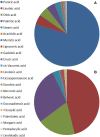Primary Metabolites, Anthocyanins, and Hydrolyzable Tannins in the Pomegranate Fruit
- PMID: 31164897
- PMCID: PMC6534183
- DOI: 10.3389/fpls.2019.00620
Primary Metabolites, Anthocyanins, and Hydrolyzable Tannins in the Pomegranate Fruit
Abstract
Pomegranate (Punica granatum L.) is an important and interesting fruit tree that is cultivated in many parts of the world. In recent years, along with the increase in its cultivation and consumption there has been a dramatic increase in the scientific interest in its biology, methods of cultivation, adaptation to environmental cues and its health-promoting properties. Quite a large proportion of the various metabolites produced in the pomegranate were determined and their content in the bark, roots, leaves, and fruit was reported. Many reviews on polyphenolic compound content, antioxidant activity and health-promoting compounds were published recently. However, only very few recent reports were dedicated to primary metabolites, despite the fact that much work was done on organic acids, sugars, proteins, lipids, and amino acids of the pomegranate fruit. In this review, a special effort was made to present these recent studies and the review is devoted to primary metabolites. The reported data show high variation in the content of primary metabolites within the pomegranate fruit; therefore the data is presented (whenever possible) according to fruit tissues (peel, arils, and seeds), developmental stages of the fruit, environmental and climatic conditions, and genetic background. Most of the data on pomegranate is based on metabolic content and contains no genetic or molecular analysis except for work done on anthocyanins and hydrolyzable tannins. In those cases, gene assignment and genetic control studies were pointed out in the review. The recent publication of the genome sequences from several pomegranate varieties and transcriptomic data from fruits, flowers, and leaves is expected to facilitate the understanding of genetic control of metabolites in pomegranate.
Keywords: fruit; lipids; metabolites; organic acids; polyphenols; pomegranate; proteins; sugars.
Figures




Similar articles
-
A review on phytochemicals, metabolic profiles and pharmacokinetics studies of the different parts (juice, seeds, peel, flowers, leaves and bark) of pomegranate (Punica granatum L.).Food Chem. 2022 Nov 30;395:133600. doi: 10.1016/j.foodchem.2022.133600. Epub 2022 Jun 30. Food Chem. 2022. PMID: 35793588 Review.
-
The pomegranate (Punica granatum L.) genome provides insights into fruit quality and ovule developmental biology.Plant Biotechnol J. 2018 Jul;16(7):1363-1374. doi: 10.1111/pbi.12875. Epub 2018 Jan 22. Plant Biotechnol J. 2018. PMID: 29271050 Free PMC article.
-
Fine Mapping of the "black" Peel Color in Pomegranate (Punica granatum L.) Strongly Suggests That a Mutation in the Anthocyanidin Reductase (ANR) Gene Is Responsible for the Trait.Front Plant Sci. 2021 Feb 25;12:642019. doi: 10.3389/fpls.2021.642019. eCollection 2021. Front Plant Sci. 2021. PMID: 33719321 Free PMC article.
-
Analysis of phenolic compounds in different parts of pomegranate (Punica granatum) fruit by HPLC-PDA-ESI/MS and evaluation of their antioxidant activity: application to different Italian varieties.Anal Bioanal Chem. 2018 Jun;410(15):3507-3520. doi: 10.1007/s00216-018-0854-8. Epub 2018 Jan 19. Anal Bioanal Chem. 2018. PMID: 29350256
-
Diverse Phytochemicals and Bioactivities in the Ancient Fruit and Modern Functional Food Pomegranate (Punica granatum).Molecules. 2017 Sep 25;22(10):1606. doi: 10.3390/molecules22101606. Molecules. 2017. PMID: 28946708 Free PMC article. Review.
Cited by
-
Unveiling the Potential of Polyphenols as Anti-Amyloid Molecules in Alzheimer's Disease.Curr Neuropharmacol. 2023;21(4):787-807. doi: 10.2174/1570159X20666221010113812. Curr Neuropharmacol. 2023. PMID: 36221865 Free PMC article. Review.
-
Pomegranate Peel as Suitable Source of High-Added Value Bioactives: Tailored Functionalized Meat Products.Molecules. 2020 Jun 21;25(12):2859. doi: 10.3390/molecules25122859. Molecules. 2020. PMID: 32575814 Free PMC article. Review.
-
Improved Cardiovascular Effects of a Novel Pomegranate Byproduct Extract Obtained through Hydrodynamic Cavitation.Nutrients. 2024 Feb 10;16(4):506. doi: 10.3390/nu16040506. Nutrients. 2024. PMID: 38398831 Free PMC article.
-
An Overview of the Health Benefits, Extraction Methods and Improving the Properties of Pomegranate.Antioxidants (Basel). 2023 Jun 27;12(7):1351. doi: 10.3390/antiox12071351. Antioxidants (Basel). 2023. PMID: 37507891 Free PMC article. Review.
-
Elucidation of Volatiles, Anthocyanins, Antioxidant and Sensory Properties of cv. Caner Pomegranate (Punica granatum L.) Juices Produced from Three Juice Extraction Methods.Foods. 2021 Jun 28;10(7):1497. doi: 10.3390/foods10071497. Foods. 2021. PMID: 34203382 Free PMC article.
References
-
- Aarabi A., Barzegar M., Azizi M. H. (2008). Effect of cultivar and cold storage of pomegranate (Punica granatum L.) juices on organic acid composition. ASEAN Food J. 15, 44–54.
-
- Ahmadi Gavlighi H., Tabarsa M., You S., Surayot U., Ghaderi-Ghahfarokhi M. (2018). Extraction, characterization and immunomodulatory property of pectic polysaccharide from pomegranate peels: enzymatic vs. conventional approach. Int. J. Biol. Macromol. 116, 698–706. 10.1016/j.ijbiomac.2018.05.083 - DOI - PubMed
-
- Akhavan H., Barzegar M., Weidlich H., Zimmermann B. F. (2015). Phenolic compounds and antioxidant activity of juices from ten Iranian pomegranate cultivars depend on extraction. J. Chem. 2015:907101 10.1155/2015/907101 - DOI
-
- Alcaraz-Mármola F., Nuncio-Jáureguib N., García-Sánchezc F., Martínez-Nicolása J. J., Hernández F. (2017). Characterization of twenty pomegranate (Punica granatum L.) cultivars grown in Spain: aptitudes for fresh consumption and processing. Sci. Hortic. 219, 152–160. 10.1016/j.scienta.2017.03.008 - DOI
Publication types
LinkOut - more resources
Full Text Sources
Other Literature Sources

